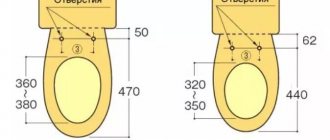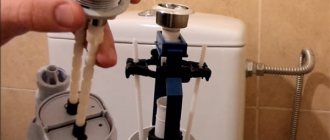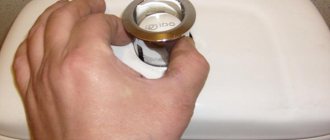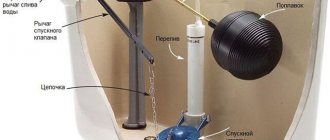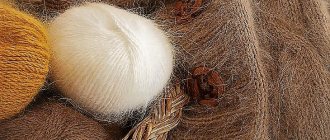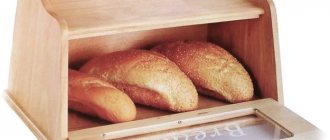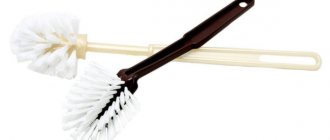Sanitaryware and plumbing
Author Anton
Date
Jan 25, 2016
0
1 705
Share
The toilet lid is an element susceptible to contamination and damage. To maintain the cleanliness and convenience of the bathroom, you need to take care of cleaning this element and replacing it in a timely manner. The service life of a plastic element is significantly lower than a ceramic product, so the toilet seat may require replacement during operation.
- LiveJournal
- Blogger
To install a toilet lid you only need to know a couple of tricks
- Removing the old cover
- Plastic fastenings
- Brass fasteners
- Steel fastenings
- How to choose a toilet lid
- Soft seats
- Standard hard plastic seats
- Seats with microlift
- Bidet seats
- Heated seats
- Automatic seats
- Installing a new cover
- Overlay shelf
- Solid shelf
- Repair in case of breakdown
Removing the old cover
You need to remove the lid from the toilet if it is damaged or if plumbing repairs are required. Removing the toilet seat can be done quickly and without much difficulty, but depending on the type of fastening, difficulties may arise. The toilet lid mount can be made of three types of material:
- plastic;
- brass;
- steel.
The easiest thing in terms of installation and dismantling is the plastic fastening. When using steel, difficulties and difficulties often arise. To fully disclose the topic, each type must be analyzed separately.
How to install a toilet seat
Before installing the seat, you need to select a tool. If the fasteners are made of metal, you will need an adjustable wrench or wrench. Plastic parts are assembled only by hand.
In the case of a solid cast shelf and separate holes, work with fasteners for the seat is done as follows:
If the tank is mounted on sanitary equipment and the toilet seat is fixed in the same place, then the procedure takes a little longer. You will need to additionally turn off the water, install a cuff and, by returning the water supply, eliminate leaks.
Plastic fastenings
Old plastic bolts can be easily unscrewed and removed. If difficulties arise, you can take an old knife and heat it to a high temperature. Gas stoves, burners or a lighter flame can be used as a heating source. The heating method is not important, the main thing is that the steel reaches the melting point of the plastic, which is in the range of 130-175 degrees Celsius, depending on the material.
Using a knife heated to the required temperature, the fasteners for the toilet seat are cut off with a quick movement. Sometimes drops of melted plastic can fall onto plumbing fixtures. There is no problem with this: drops of material practically do not come into contact with the ceramics and are not capable of strong adhesion. After hardening, they are easy to remove from ceramic or earthenware surfaces.
After unscrewing or cutting off the fastening for the toilet lid, remove it and thoroughly clean the surface under the lid, which was inaccessible for cleaning. Then you can begin installing the new product.
Brass fasteners
If the toilet lid mount is made of brass, dismantling it will be quite simple. Such elements unwind easily, but if problems arise, you can use a method that reduces surface friction.
To do this, you will need a few drops of kerosene or special lubricant (use, for example, WD-40). The substance is used to treat the threads and surface of the plumbing fixture at the mounting location. After this, the toilet lid mount should be easy to unscrew. Then proceed as in the previous case: clean the surface and begin installing a new plastic product.
Repair
Toilet seats also have to be replaced and repaired.
Problems under the shelf
If a seat with a separate shelf is replaced, a leak may occur during the work. Possible reasons:
The solution to these problems is to completely replace the rubber element. But sometimes one wire is enough. It is used to tighten the cuff in places of sealed contact with areas of plumbing equipment. An alternative is silicone sealant. But both options don't help for long.
Broken plastic elements
Under the influence of a point load (impact, falling objects) and weight exceeding the limits, the seats easily crack, deform or break. If you can’t replace the seat, you can bring the toilet seat into a condition suitable for temporary use. There are only two ways: gluing and fusion .
Many plastic products tend to dissolve when exposed to acetone. The liquid must be applied to the damaged area to be fixed. You can use the product after the material has completely dried. Dichloroethane works in a similar way. But you need to be careful with it, as it is toxic.
Superglue and quick-setting gel often contain cyanoacrylate. This substance has high adhesion to polymers. Therefore, with the help of such compositions it is also possible to carry out repairs by gluing.
If there are no chemicals or liquids at hand, then chips and cracks can be subjected to heat treatment. When heated, the edges of the plastic begin to melt. Just press it down and let it cool. And after that, the seams are sanded with an abrasive material with a fine grain fraction.
Broken toilet ears and shelf
The lack of additional support elements and incorrect installation of the tank lead to incorrect distribution of the load on an individual shelf. As a result, the ceramics may burst, that is, the ears break. You can make repairs using epoxy glue:
After installing the lid and tank on the toilet, it is recommended to provide the structure with additional supports. For example, you can place a beam under a shelf or lay it between a wall and a water container. If this is not done, then next time the scale of the breakdown may be larger and you will have to completely replace the equipment.
Steel fastenings
If the old toilet rim is attached to steel bolts, this becomes a real problem. Steel is a material prone to corrosion (rust). There is always high humidity in a bathroom or toilet, which leads to an increase in the rate of metal corrosion. Rusty toilet seat mounts are not easy to remove, but they are quite possible. There are several ways to do this.
- Penetrating lubricant applications. To do this, you need to purchase a special compound from a hardware store that penetrates deep into the joint and has a freezing effect. The principle of operation of such a substance is that when applied to a corroded element, rust cracks and is easily removed.
After treating the damaged elements, they need to be wrapped in a rag, which will increase the effect of the impact. After waiting for 10-15 minutes, you can try to unscrew the bolts with a socket wrench. This method of dealing with rust is not suitable for very advanced cases, therefore, if rust has severely damaged the elements, it is recommended to use the second dismantling option.
- Using an electric drill. For the work you will need to prepare a set of drills of various sizes. First, take a 0.25-inch drill bit. In this case, the work must be carried out carefully and slowly. If you hurry, you can damage the body of the earthenware or ceramic product by accidental movement.
The next drill bit is 1/16 inch. They continue drilling. After this, you will need a socket wrench to loosen the bolted connection. Once the mount is not firmly attached to the toilet, it will be easier to dismantle it.
- LiveJournal
- Blogger
The most common steel toilet mounts
After the fasteners are removed, you need to explore the range of new products.
How to choose a toilet lid
The stores offer a wide range of toilet products. Buyers sometimes pay little attention to this, but user convenience depends on this issue. The most common modifications include:
- soft toilet seat;
- hard plastic seat;
- toilet lid with microlift;
- automatic products;
- seat with bidet function;
- heated toilet lid;
- baby cap.
The choice depends on the financial capabilities and requirements of the client.
Design and material of manufacture
Based on their design, seats are divided into soft and hard. Soft models are covered with vinyl or polyethylene on top; they are very inexpensive, have a bright, cheerful design, are easy to use, but will not last long, since the upholstery will quickly tear or crack. Hard models are more reliable, they are not so afraid of mechanical stress, sharp objects and the aggressive effects of detergents. In addition, you can always put a special cover on the hard cover, which can be easily changed. The assortment includes a wide variety of covers made of plush, textile, eco-leather, vinyl, with a zipper or ties.
Today, manufacturers usually use two materials to make lids:
- Plastic;
- Duroplast.
Of course, there are also seats made of wood and MDF, but quite rarely and most often these are designer models that are rarely found in ordinary stores.
Plastic seats are cheaper and lighter, but they are easily scratched and break quickly.
Duroplast is a more modern material, it is stronger, which means this model will last longer. Another plus is that such seats often have an antibacterial coating, which is very important for maintaining hygiene in the toilet. True, such options are more expensive than conventional plastic ones.
Seats with microlift
The toilet lid microlift is designed for soft and smooth lowering, which guarantees extended service life of the product. Another advantage of seats with a microlift is that they are made from high-quality materials. The disadvantage is the increased cost.
- LiveJournal
- Blogger
A soft toilet seat is almost twice as expensive as a regular one.
When using this product, you need to remember that forced manual lowering will cause the lid for a toilet with a microlift to break. Modern models are equipped with a special button that turns off the smooth lowering mechanism. In this case, the process occurs with the usual roar. If the toilet lid microlift breaks, first find out the reason. Breakdown options:
- The lift toilet lid has rotated and become detached from the toilet at the base.
- Broken fasteners.
A toilet lid with a closer is complicated, so to repair it, turn to professional workers for help. In the vast majority of cases, repairs are impractical; it is easier to immediately replace the product.
Automatic seats
The product is a modern toilet lid, which has the following functions:
- automatic lifting when a person enters the room;
- automatic lowering after a person leaves the bathroom;
- smooth lowering and lifting;
- heating.
The cost of the product compared to conventional lids with a closer is twice as high.
- LiveJournal
- Blogger
An automatic toilet seat is the most expensive model.
What should you pay attention to when choosing a product?
To select a toilet lid without errors, you need to check its compliance with the following criteria:
- convenience;
- lifetime;
- dimensions;
- seat type and additional functions;
- colors;
- quality of material.
If you take measurements of the product before going to the store, there will be no problems with the third point. Colors should be selected depending on the decoration and style of the room. The quality of the material must correspond to its price.
Variety of toilet seats
Having decided to change the seat, the owner pays attention not only to classic models, but also to improved options. There are a huge number of them.
Types of toilet seats based on material used:
- plastic - the most common due to their low price, ease of maintenance, light weight, quickly heat up from body heat, but are susceptible to scratches and cracks;
- wooden - rare, but practical and comfortable, creating a warm atmosphere; if the lid falls, damage to the toilet may occur;
- duroplast - a version of plastic that has the qualities of ceramics, is resistant to impacts, moisture, weak acids, contains antibacterial components, but is quite cold and expensive;
- fabric ones are more of a decorative option, which perfectly complements the interior, but quickly wears out, losing its attractiveness, and is unhygienic to use.
Overlay shelf
This design is also called “eared”. You will need to install the toilet lid in the same holes as the cistern, which complicates the work. Attention is paid to:
- Type of fasteners. For fastening, only brass or plastic fasteners are used, since steel is susceptible to corrosion.
- Plastic washers are provided for brass bolts. If secured using metal elements, the toilet may be damaged.
- Preventing the shelf from moving relative to the toilet. In this case, the tightness of the tank structure will be broken and leaks will occur.
- Steel fasteners must not be used. Their use will lead to corrosion and problems during further repair of the device.
To install the seat, you need to lift the toilet tank. At the same time, check the integrity of the cuff between the tank and the toilet.
Methods for attaching the toilet seat and lid
Here the shape of the toilet plays a big role, namely what kind of shelf it has - solid or overhead.
- A model with an overhead shelf (it is also called “eared”): you will have to tinker with it a little longer, because the toilet lid is attached to the same holes where the flush cistern is attached. You will need polyethylene fastening clamps, which are installed on the bolts that secure the shelf to the toilet.
A few simple tips to help you install the seat on a “eared” toilet:
Installing a toilet seat
- use only plastic or brass fasteners;
- if you use brass fasteners, install plastic washers under them - otherwise there is a high probability that, when tightening the bolt, you will break the toilet itself;
- When fastening the toilet lid, do not use steel bolts: they will rust unnoticeably and the next time you dismantle the lid you will have problems removing them.
Be careful: when dismantling the seat in this toilet model, the shelf may move. As a result, the rubber cuff will allow water to pass through. To fix this problem, you will need any light source - you will have to look under the toilet tank. Check the condition of the cuff: if it is not torn, but is leaking from the place where it connects to the toilet, it will be enough to simply tighten the end of the cuff with thick wire. If the cuff is cracked or burst from prolonged use, then nothing can be done - you will have to change it.
This procedure is simple, but takes some time: you need to turn off the water and remove the drain tank, and then the old cuff. It is good to clean everything from accumulated dirt and limescale. Then take the purchased cuff and put its narrow part on the shelf. Then the cuff should be rolled up. The flush tank needs to be put in place, then roll out the cuff and put it on the socket of the toilet.
- Model with a solid cast shelf: everything is as simple as that - to install the seat, special holes are made into which fasteners are inserted that clamp this very seat.
